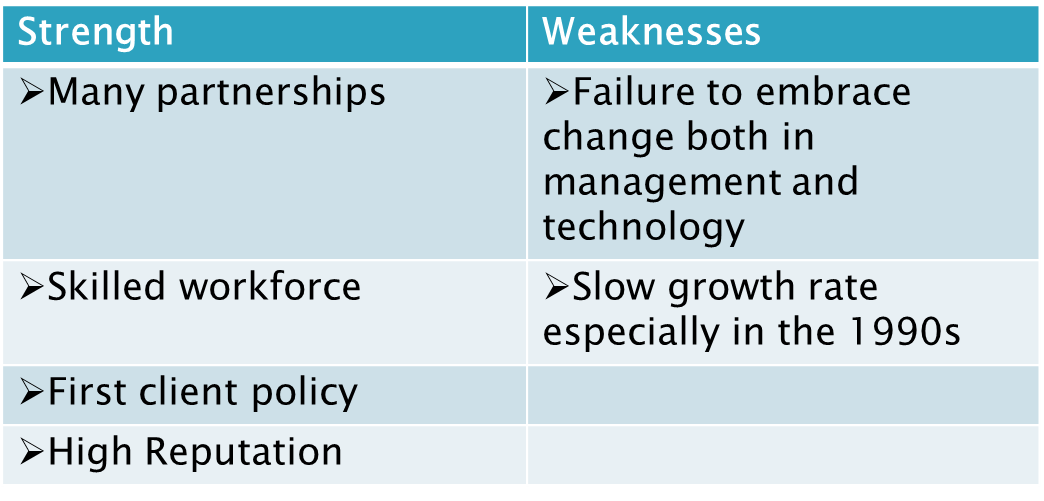SWOT Analysis
The company has more than 300 management consultants in more than 58 offices (Nanda & Morrell 2004, p. 4). The company hires people who are well trained and have no motive for self aggrandizement (Nanda & Morrell, 2004, p.9). The firm has 122 partners, 200 nonpartner consultants and 240 researchers, all university graduates. All these operate from 58 offices distributed in more than 39 countries.
The company adapts one firm partnership concept where all offices are owned by partners. The company has built its reputation for quality for over 36 years. The company has offices in Europe, the Asia Pacific, the Middle East and the Americas. Clients range from Mid-Cap businesses to Fortune 100 international companies to entrepreneurial ventures and not-for-profits. The client first idea was drove company as all functions of the weaknesses.

Many firms have been emerging and are eating into the traditional markets of EZI (Nanda & Morrell 2004, p. 12). These has been as a result of internet growth. The initial growth rate of the company was very slow as it relied on its meager returns to set up other subsidiaries. The fee charged by EZI were higher than those charged by competitors (Nanda & Morrell 2004, p. 6). This is depicted in the way old employees were leaving the firm; the new young employees did not have enough motivation to adopt to changes (p. 12).
The company has a reach global market. It has growth potential in European market, Asia pacific, North American and South America. The company also has continued acquiring new partners to enhance its business. Some of these acquisitions include Seoul in 2001 and Miami in 2000 (Nanda & Morrell 2004, p. 14). Some of the new products and services introduced include insurance services, financial services and life sciences (Johanson & Sudzina 2009).

The internet created new challenges for EZI as new companies with faster search sites have kept emerging (Besanko 2007). Continued loss of professionals to competitors also has been a great threat posed to EZI (Nanda & Morrell 2004, p. 6). The cost labor forced the company to dismiss some of its top management employees (Porter 2008).
PEST Analysis

The concept of executive search in EU was new and with this, the company received a lot of threats from companies.

Social factors
The firm operated as a single with 39 nationalities which was a big challenge. To remedy this, the firm adopted the partnership approach.
Technological changes
There have been changes in terms of technology and this has greatly affected Egon Zehnder.
Environmental factors
Corporate leaders emphasize the significance of environmental efforts at all organizational levels. Egon Zehnder International has exceptionally strong methodology used to evaluate leadership competencies that not only complement, but also transcend environmental expertise. The company is passionate about sustainability and corporate social responsibility. To their clients, sustainability carries two meaning: it directs their social and environmental aspects and second it enhances their bottom line.
Legal
International negotiation is a very complex process with a good number of factors impacting the outcome of it (Johanson & Sudzina 2009). This is based on the fact that it relates to global Corporate Governance which is managed under a number of conflicting legal systems. The challenge of enhanced pressure regarding compliance. As the company operates in many countries it faces the challenge of compliance with relevant state laws.
Reference List
Besanko, D. 2007, Industry analysis. Economics of Strategy 4th ed, pp. 337-357, Wiley & sons, New Jersey.
Nanda, A., & Morrell, K. 2004, Strategic review at Egon Zehnder International. Case Study, pp. 1-23.
Porter, M. 2008, The Five Competitive Forces That Shape Strategy. Harvard Business Review, pp. 24-41.
Introducing Strategy.
Strategic Position the Environment.